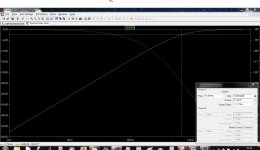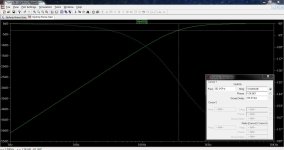Do you know why I am getting this harsh brittle treble, I have changed to the lm49710 but no improvement in treble when compared against the stock op-amp.
Have you put a scope across the speaker when it sounds like this to check there is nothing untoward going on?
No sorry i don't have a scope, i'm following the instructions in this thread and hoping it is all correct. I did read something on page 3 # 45 about reducing harsh treble so this problem has been recognised and addresed
I've changed the stock op-amp for lm49710 but the harsh treble is still there
I've changed the stock op-amp for lm49710 but the harsh treble is still there
Impossible to say without at least knowing if the output is clean. Simple tests with a scope tell so much.
Don't think the quad output is clean. I have tried a bryston amplifier and the harsh treble is gone. So must be something to do with the quad. Wondering if any of the op-amp mentioned earlier may help, bypassing the op-amp, adding caps to the op-amp power supply, or anything else.
It really is impossible to say without proper diagnostics. You may find it is unstable, or just doing something odd on either positive or negative going parts of the signal.
Also, is it really doing something untoward or is it just a 'characteristic' of the Quad. Without tests we just can not say.
Also, is it really doing something untoward or is it just a 'characteristic' of the Quad. Without tests we just can not say.
Thanks! On the DeSmith site it says gain is 330k / 22k = 15. Dropping 330k down to 100k = 4.5
There is a 47nf cap between the two resistors but no mention is made what to do with this, should this be left alone.
There is a 47nf cap between the two resistors but no mention is made what to do with this, should this be left alone.
Its a surprisingly complex circuit in the way it all interacts. Those resistors only set the midband gain of the opamp stage, there is also another feedback loop around Q2 (R16 and R20/21). Cap C2 plays a big part in setting the roll off slope at LF.
Standard Quad.

330k to 100k gives a nasty LF peak.

100k and 130nF. C2 is now 25uF and C1 is 2.2uF

Standard Quad.
330k to 100k gives a nasty LF peak.
100k and 130nF. C2 is now 25uF and C1 is 2.2uF
In my quad, i have dropped C1 down to 47Nanofarads from 680nf, as i have an active subwoofer to reproduce the bass, everything up to 120hz, the quad takes over from 120 hz upwards, so a bump in the LF response of the amp should be no concern to me
No. It should be increased in the same ratio that you decrease R6 , for example if R6=100k, C4=150nF.There is a 47nf cap between the two resistors but no mention is made what to do with this, should this be left alone
Thanks! R6 = 100k, C4 =150nf, R1= 47nf, is that good to go.
Did adding small 4uf caps to the op-amp power supply make any audible improvements, heard a few people do it but no reports if it actually made an improvement.
There are also a few reports of placing caps across the op-amp itself, did these make an actual audible improvement, if so which caps would you use
Did adding small 4uf caps to the op-amp power supply make any audible improvements, heard a few people do it but no reports if it actually made an improvement.
There are also a few reports of placing caps across the op-amp itself, did these make an actual audible improvement, if so which caps would you use
And C2=33uF. All this is necessary to preserve the LF time constant. But if you're changing C1 to 47nF that changes it again, so I would have to reconsider. You seem to be aiming for 150Hz (22k and 47nF), is that correct? In which case C4=10nF and I would have to think about C2.
Bypassing power supply electros is 30 years out of date IMHO, but if you have them you could just try it and see.
Bypassing power supply electros is 30 years out of date IMHO, but if you have them you could just try it and see.
Thanks! Let me know when you have the component values.
Is R6 100k the best resistor value to go for in terms of sound quality, the lower value when compared to the stock 330k increases negative feedback and lowers distortion, would lowering the resistor any further from 100k give even lower distortion and better sound
Yes, i have an active subwoofer to reproduce everything up to 120hz, so the quad only reproduces everything over 120hz. Do you think C1 47nf is okay or should i go for a smaller cap. The attenuation rate of the cap does appear to be quite gentle
Does the 150nf C4 cap you mentioned have to be of decent quality, is it in the signal path
Is R6 100k the best resistor value to go for in terms of sound quality, the lower value when compared to the stock 330k increases negative feedback and lowers distortion, would lowering the resistor any further from 100k give even lower distortion and better sound
Yes, i have an active subwoofer to reproduce everything up to 120hz, so the quad only reproduces everything over 120hz. Do you think C1 47nf is okay or should i go for a smaller cap. The attenuation rate of the cap does appear to be quite gentle
Does the 150nf C4 cap you mentioned have to be of decent quality, is it in the signal path
I suggest you're changing sensitivity much more than sound quality here. With R6=100k you now have 1.5VRMS sensitivity for full output, and I suggest that's as far as you want to go. There is instability if you go further. I don't know when it kicks in, as I've never gone beyond 100k myself.
If you want 120Hz HP your C1=47nF is too small, but if you want to implement the crossover in the Quad we need more information. What is the slope of the subwoofer's LP filter? You want to use the same order filter for the high-pass. You should really be using a 4th-order Linkwitz-Riley filter for best effect, both HP and LP. The Quad can give you 3rd order but not 4th. I would leave the Quad's time constants where they were designed, apart from what I've given you for C2/4, and use external means to implement the crossover.
The attenuation rate of one RC network is first order, 6dB/octave, not sufficient for any speaker crossover.
All components are in the signal path, and C4 is certainly no exception.
If you want 120Hz HP your C1=47nF is too small, but if you want to implement the crossover in the Quad we need more information. What is the slope of the subwoofer's LP filter? You want to use the same order filter for the high-pass. You should really be using a 4th-order Linkwitz-Riley filter for best effect, both HP and LP. The Quad can give you 3rd order but not 4th. I would leave the Quad's time constants where they were designed, apart from what I've given you for C2/4, and use external means to implement the crossover.
The attenuation rate of one RC network is first order, 6dB/octave, not sufficient for any speaker crossover.
All components are in the signal path, and C4 is certainly no exception.
No, you should answer my question.So I should go with R6= 100k, C2=33uf, C4= 10nf, C1= 47nf
I'm not sure what you are trying to do tbh 🙂 Those values reduce the midband gain from around 35db to 24db
(I'm kind of intrigued by your images above... opamp noise gain, and the task bar layout looks like how I used to have Vista set up)
View attachment 1173795
Thanks! What component values would you use to reduce the quad sensitivity, and at the same time roll of the low frequencies, everything under 150hz or so
- Home
- Amplifiers
- Solid State
- QUAD 405 clone

